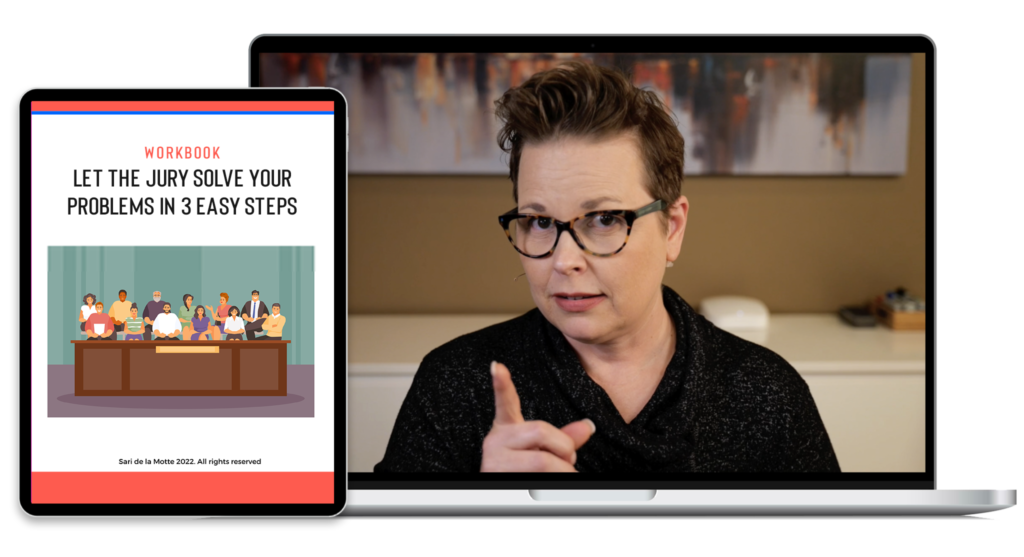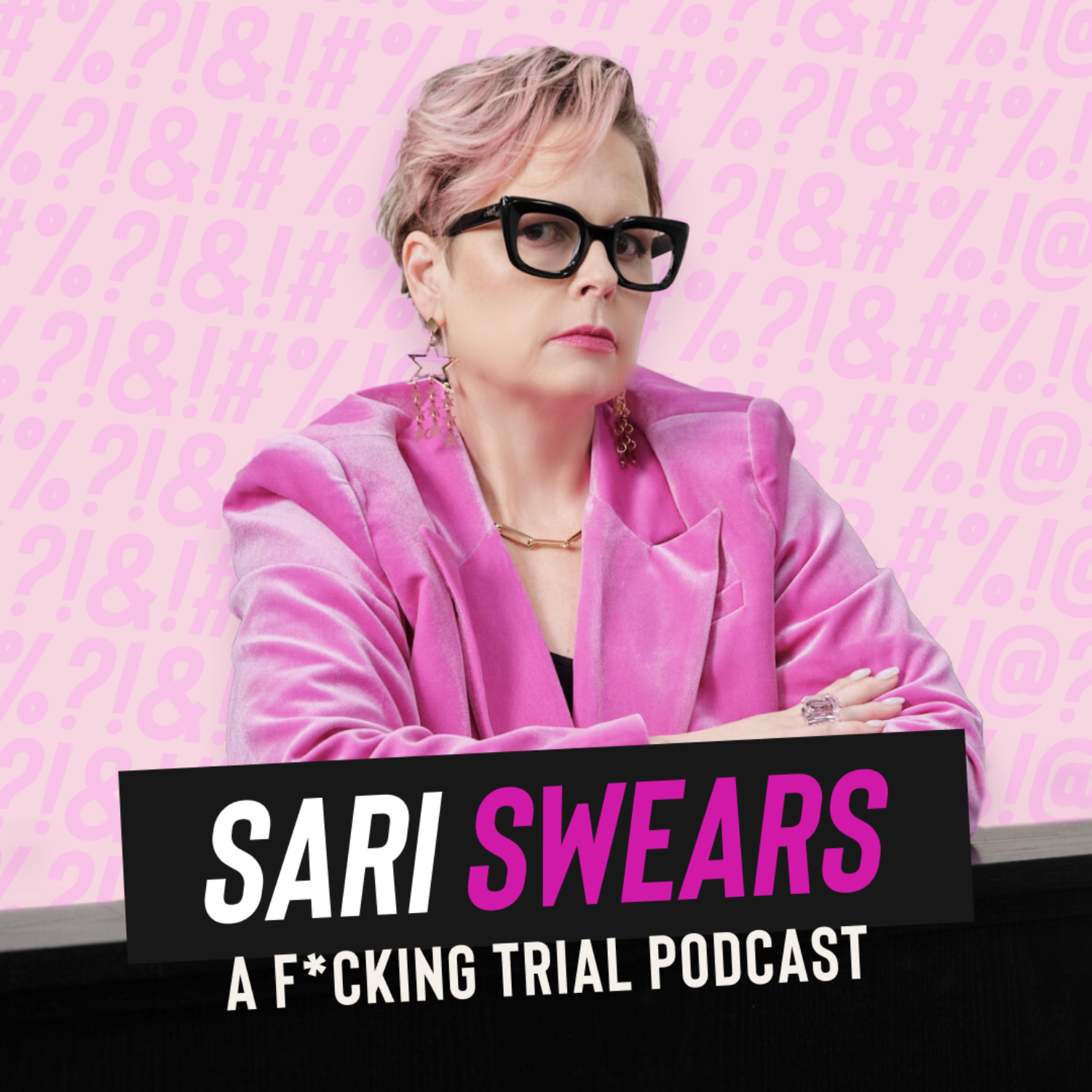Most attorneys think their job is to present information to the jury.
But here’s the truth: presenting isn’t enough — you NEED to perform.
The best trial attorneys don’t JUST deliver a case.
They OWN the courtroom, COMMAND attention, and MOVE jurors to action.
Here’s what we’re covering:
? The four levels of trial presentation — and why most attorneys never reach the final stage.
? Why writing out your opening statement could be quietly killing your persuasion.
? How to stop “presenting” and start connecting with jurors so they take action.
Most attorneys get stuck trying to “get it right.”
But when you MASTER this approach, you STOP performing for jurors and START influencing them.
Tune in now ?
Xo,
Sari
➡️FREE FB GROUP FOR PLAINTIFF & CRIMINAL DEFENSE ATTORNEYS
"If you think your job is just to present information to the jury, you’re already losing. Jurors don’t give a shit about your polished script or perfect delivery — they care about how you make them feel. If you want to win, stop performing for them and start connecting with them."
sari de la motte
ENCORE EPISODE TRANSCRIPTION
Hello everyone. Sari de la Matte with you, the Attorney Whisperer for another episode of From Hostage to Hero. I'm so glad to be with you today on camera again. A little bit weird. Normally I'm just in my pajamas and doing my thing and talking to you, but this is also nice. I hope that you're enjoying it, whether you're still just listening or whether you're watching the video. Welcome to all of you today.
Well, today we're talking about the journey from a presentation to a performance. So this came up in the H-to-H crew a couple of weeks ago where we had someone who'd been coming in and taking a bunch of hot seats. In the crew, back in the crew, you can sign up on the third Friday of every month for the next month's hot seats, which are with me either for honorable, well, we don't call it that anymore, presentation skills coaching where you come in and bring part of your opening or wad your circle.
And so this was presentation skills coaching, and the same person just waiting, clicking on the button every time that it's available, which so awesome. That's awesome. He wants to get so good. And so it came up once he came in, I said, "You've now moved into the next phase of your journey from this presentation to performance." In fact, one of our H-to-H crew members gave me that little metaphor from presentation to performance. So thank you for that.
I want to take you through the four iterations that I see most of you go through. In fact, most of you only ever end up at level three, and what I'm hoping to get you to by working with me or if working with another coach is to that level four, because all good things happen in that fourth level, that performance level when we get to presenting information of any kind to an audience.
So here's the four levels in the basic gist. The first level of getting information across from you to someone else, and let's use a law example, is just talking about your case. So perhaps using the H-to-H crew as an example, that would be coming into a case workshop. So you've got a hot seat with one of our coaches and you come in and they're like, "What do you need help on today?" And you're like, "I just need help with some strategy on my case." And they go, "Tell me about it." Right there as you start to talk about your case, that's level one. So you were just telling someone else about your case, about the facts, about what it entails. That's level one.
Level two of giving information to someone else is when you start to do what I call the science. So the science is where you're putting it together. You're like, "Okay, here's my teaching section. Here's my three part, okay, I've got my hook and then I've got my story. We're going to start here and then go forward on the timeline, and then I'm going into the challenges." You start to put it together. It's the nuts and bolts. It's the science of presenting. So somebody might come into a presentation skills training and they're in level two, so they're like, "Okay, I've just put this together and I want to try it out on you." And so they do their five minutes of presenting and I go, "Okay, well this doesn't make sense. Let's move this over here or let's start with that, or let's reword this." That's the science. We're just getting it the way that we like it.
The third level on your journey from presentation to performance is really when you get into presentation mode. So this is where you are ... You know what the order is, you know how to deliver your content. And now when you come into a presentation skills coaching session with me. We're now working on how you're gesturing. We're now working on when you should walk. We're now working on putting in some pauses, right? We're now moving from the content, the nuts and bolts, to the delivery. How do we want to say this? What tone of voice do we want to use? How quickly we'd want to speak? Where do we want to slow down? How do we want to non-verbally mark?
Now, if you ever get to that point, some people don't even get to level three, that's where most people stop. And what today's podcast episode is all about is that you have to keep going because what I want you to do is go back as you've gone through these three levels and go to level four, which is the most guess which level? Level one. So it's funny, as I'm working with people and I'm pushing them now into the art space, so where they're really becoming an artisan, they're really becoming an artist as they are creating this content and delivering it to their audience, they really go back to how they were talking in level one.
Level one, remember, was where you are just telling us about your case and you're not thinking about presenting it. That's where this level four lives with good non-verbals, with good presentation skills. Now, I want to talk to you a little bit about why this is so important because I think when you're putting together an opening statement or a CLE, anytime when you're presenting in front of somebody else, you tend to think that your job is to get information across. That you have information and that your job is to give it to someone else. And that's kind of how it comes across, and that's the problem.
So when we go back to think about what we're asking jurors to do, what your job is as a plaintiff attorney, your job is to motivate them to act, right? The easiest thing, you've heard me say this before, the easiest thing is for someone to not act, right? Just leave things as they are. And so the reason why or one of the reasons why your job is so difficult is because you have to motivate someone to do something, and that's hard. Now, notice that I'm using the word motivate instead of persuasion, right? Motivate versus persuade. Now, if you look them up in the dictionary, which I did because I do that, they're fairly similar, but in my mind those two words and those two things are completely different, mostly in terms of energy.
So I want you to think about an exercise example. So if I don't feel like exercising and my husband does and he wants to persuade me, he might be like, "Come on, let's do this. It's good for you. I'm going to do it. Let's go over here. Come on." That to me feels more like persuasion. He's trying to get me to do something that I don't want to do. I see motivation as different. Motivation is motivating someone should do something that they do want to do, but that for some reason maybe difficult in the moment. Maybe I do want to work out, I do want to be healthier, but I also want to eat pie, which I'm going to do after this podcast and watch TV. So there's these two things, both of them I want to do. Now, I might need to motivate myself or have my husband motivate me to do something I already want to do, and I don't think I even recognized that that is the difference in my mind until I was podcasting with you today.
But that's the difference in my mind. Persuasion in my mind is trying to get someone to do something they don't want to do, where motivating someone is to do something they already want to do, but for some reason it's difficult or there's some kind of obstacle in their way. Notice the energy is different. One is this pleady, convincing energy, and another one is more cheerleader. Like, "You can do this. This is good for you, it's good for the community, it's good for the world at large." Do you notice that the energy's different? One is a pull, "Come on, this is the right thing to do," versus a push. "You can do this. I know you can. I believe in you." Think about this with your kids. Very different energy.
Now, when you are in the art space, that level four where you are now moving beyond presenting, you got the content down, science, you got the delivery down, which is that presentation part, but now you're going to go to this place where you are motivating jurors. And we motivate jurors not by just delivering information, because if we could motivate jurors that way or any audience, then we would just type up the content and let them read it on their own. I mean, if it was the information that motivated, that would be enough. And sometimes information is that compelling and motivating that on its own, it motivates people to act, but rarely, especially in our plaintiff cases.
So you need to get out of presentation mode and now become a presenter that is in this art space where you're just talking to us with good non-verbals and your content firmly down in a way that motivates us to act. See, you can't do that when you're trying to deliver a presentation. When you think I'm trying to get the words right, I'm trying to get the order right, I'm trying to get my hands, you cannot be in a position to motivate. It's more about you than your audience at that point. It's more about what you look like and what you remember versus how they're feeling and how they're being motivated. But when you have practiced it to a point where you can leave that and you can be in this space of just talking because your case so well, that's what gets jurors motivated to act.
Now, there are three things that I want you to avoid in any of these stages so that you never get to that position where you are giving a presentation versus being in the art space of performing. So the first one is, I don't want you to ever write notes and create your opening, like typing ever, ever, ever. I don't ever want you to sit behind a laptop and type out your opening statement. I know that that is very different than pretty much all of you have ever done your opening statements. But here's why. When you start to type out an opening statement, what you're going to be doing is you're going to be thinking about words and you're going to try to get those words because you wrote those words and you wrote them for a reason, and you think it's pretty good and you put it in an order that that makes sense to you.
So your brain's going to want to go back and try to remember the words that you wrote. We don't want to start that neural pathway loop because you're creating a neural pathway when you do that. What we want instead is body memory, muscle memory. So the only notes that we create when I'm working with a client is on a flipchart. You know that I love my flipcharts, but I use them even when I'm not in trial. I use them with my clients just creating their opening. So we might start with writing out the opening role. We want to have that memorized, right? We wordsmith that to death, and that's the one thing I'm going to allow you to memorize.
And then I say, "Okay, teaching, what are our three points?" So then we have click, click, click, and we just write a word or two for the three, and we just practice delivering it. It comes out different every single time. And the more that we do that without notes, the freer it gets, the better it gets. All right, we're getting it into the memory. I go, "Okay, defendant's story, where do you want to start?" So I'll just put Roman numeral three, and then, so we'll start creating the defendant story and I'll say, "Okay, what happens first?" And they might say, "Well they're at a parking lot," so I'll just put parking lot just in my mind. And we were in the H-to-H community just a couple days ago, and somebody said, "Instead of trying to recall your notes," and this is a second tip for you, "Recall pictures, recall visual images." And you can't do that if you started with typing.
This is going to help you. As you tell that story, you're going to remember the parking garage, you're going to remember the car the defendant gets in. You're going to remember the road that they're going down. That's going to allow you to tell that story without notes. But if you type all that out, then your brain's going to try to recall the words where we want you to recall the pictures. So start by actually walking the road, actually getting in the car, doing the things in a storytelling way. Remember I've said before, "If I can't tell, if I turn the sound off and I'm watching video of your opening, and I can't tell whether you're teaching or telling a story, you're doing it wrong."? Well, this is the part of the story where you're walking and you're using your arms. All of that is creating muscle memory so that you don't need to recall actual words that you can actually go and get this into your muscle memory.
The third thing well is create body memory. So one, don't write the notes. Two, recall from pictures, and three, create that body memory by standing up and doing the things. Now, what does it have to do with getting you to level four? I got to start writing my opening, and you start standing up and having flipcharts and walking around your room and getting it into your body and vocalizing it and trying it different ways going. "That's not the wording I want. Let me try it this way. That's not the wording I want either." In fact, when I'm working with clients, even on Zoom, they're standing, I'm standing. We're we're just trying it all on. You're going to get faster through those first three levels so that you can get to this space where you're really performing and playing and working with your audience versus giving a presentation.
That's the bad news is that you have to go through the first three steps. You first have to kind of vocalize about your case, tell somebody about it, then you need to start putting it together, and then you need to practice it with the right nonverbals, and then you get to fly into level four, and that's where jurors get motivated in that space. Anything less than that is just delivering information. Might be delivering it well, but it's not motivating. It's motivating when you're not on script, you're not trying to recall. Why? Because when you're trying to recall information, jurors can tell because you're in your head now, you're not with them. But when you know it, because it's in your body, because you've trained it into your body, now you're playing with it, now you're noticing how it's affecting jurors. Now you can really go in and bring your voice up or bring it down low or go real quiet or go really loud.
You can be in the moment because you're not trying to remember a script, and that's motivating. You're with your audience, you're with your jurors. So what level of presentation are you at? Are you just at the point where you're just talking about it with somebody brainstorming about it? That's great. That's level one. Next step is start to put those building blocks together, but don't get behind a laptop and do it. Stand up, start organizing it the way you want. Start trying it out, wording it, seeing what fits, what doesn't, getting rid of things, adding things, deleting things on a flipchart as you walk around, then you start practicing that shit with good nonverbals, walking around, pausing, stopping yourself. Again, none of this happens behind a laptop.
And then you'll get to the point where you're just flying with the audience and you're motivating them to act because you're just talking like a normal person. It's not a presentation. Let me tell you what happened here. You're storytelling, you're teaching, you're not just presenting. You're there. You're alive, you're real, you're present. That my friends, is the journey from presentation to performance. And that level four is what we're all after. It's so fun when you get there. You can tell when you're there. The audience can tell too.
All right, I hope that's helpful. Talk soon.
Have you ever wished you knew what the jury was thinking? Well, grab a pen and paper because I’m about to give you instant access to a free training I created for plaintiff trial attorneys. It’s called Three Powerful Strategies to Help You Read a Juror's Mind, and it will help you understand what the jury is thinking so you can feel confident and trust yourself in the courtroom.
Ready? Head to sariswears.com/jury and enjoy!


Free Training
3 pOWERFUL STRATEGIES TO HELP YOU READ A JUROR'S MIND
Let the Jury Solve Your Problems in 3 Easy Steps
Join me for a free training to understand what the jury is thinking so you have the confidence to trust them - and yourself - in the courtroom.
Use the H2H Funnel Method so that jurors tell YOU the principles of the case instead of you telling THEM.

Subscribe to the Podcast
Tune in weekly as Sari shares tips that will help you up your game at trial, connect with jurors, and build confidence in your abilities so that you’ll never worry about winning again.
Sign up for trial tips, mindset shifts, and whatever else is on Sari’s brilliant fucking mind.




